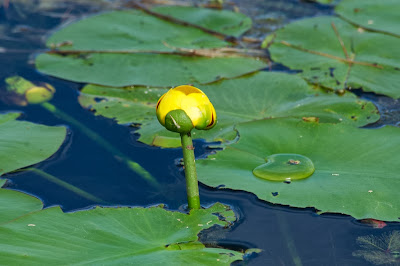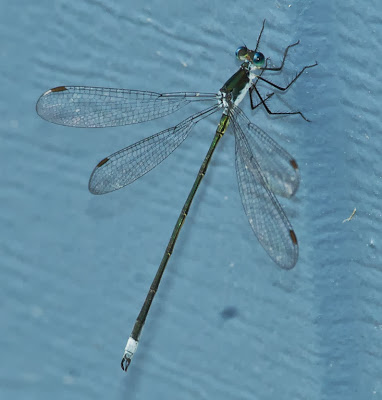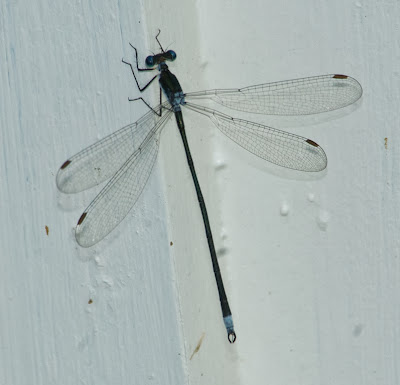For the weekend of July 8-10, 2012, our friend Vanessa Kwan invited us to her brother Nelson's cottage on Stoney (or Stony) Lake, one of the Kawartha Lakes northwest of Peterborough in southern Ontario. Besides getting together with a gang of friends (including my old friends Tom and Pat Petiet, visiting from Ann Arbor, Michigan), I was eager to explore the area.
Stoney Lake itself is large, cottage-lined and boat-filled, but Nelson's cottage is in a shallow, protected bay at its eastern end, connected to the lake only by a narrow channel.
Its shores are lined with vegetation, and its waters are quiet and lily-covered, with both White (or Fragrant) Water-Lilies (Nymphaea odorata)...
...and Yellow Pond-Lily (Nuphar variegata).
In short, it is ideal for lakeside dragonflies and damselflies (the dragonflies were so numerous, in fact, that I have had to save them for a later post). As soon as I could find an excuse, therefore, I headed down to the cottage boat dock, camera and monopod in hand.
To my delight, I found an assortment of odonates right by the dock - not to mention a collection of exuviae (the shed skins of larval Odonata) clinging to the boathouse door, where their owners had crawled out of the lake before cracking their skins down the back and emerging, to wing away as adults. I believe this one is one of the libellulids, the most obvious and diverse dragonfly family in the area, but I am by no means sure.
This one however, appears to be the exuvium of one of the emeralds (Corduliidae), possibly a baskettail (Epitheca sp.) As I saw no adult corduliids on the lake, I cannot, again, be certain.
The boathouse door, for some reason, seemed particularly attractive to spreadwing damselflies (Lestidae). Maybe because it was painted bright blue? Who knows? Anyway, I found two species fluttering and perching about it. The first was a spindly and spectacular creature, with legs, wings and needle-thin abdomen sticking out crazily in all directions.
After some examination of my photographs I came to the conclusion that this was a male Swamp Spreadwing (Lestes vigilax), an apparently uncommon species distinguished by its unusually flimsy, hairlike paraprocts or lower claspers. This one seems to have list its left clasper, but if you look closely you can see the right one between the much sturdier cerci, or upper claspers, at the end of the abdomen. The other possibility is the extremely similar male Elegant Spreadwing (Lestes inaequalis), but in that species the paraprocts are longer than the cerci and the back of the head is pale rather than bronzy. Whew!
Here is another Swamp Spreadwing (I suppose), this one adopting a more natural perch on a lily pad.
Much more sedate and unobtrusive, despite their bright colours, were a few Emerald Spreadwings (Lestes dryas), smaller insects than the Swamp Spreadwing. They held their wings folded decorously over their backs, as though they were trying to convince me that they belonged to some other damselfly family.
Bluet damselflies (Enallagma spp.) are notoriously difficult to identify without close examination of their genitalia. There appeared to be two species around the boat dock, an "intermediate" type with a moderate amount of blue showing on the upper surface of the abdomen...
.....and a little insect of the "blue" type, staring me down as I tried to focus on it with my massive 400mm lens.
This damsel is, I presume, a female Eastern Forktail (Ischnura verticalis), though on that species the spots between the eyes are supposed to be orange while these are clearly blue.
On our first day Nelson took us on a cruise around the lake. Most of our time was spent gawking at expensive cottages...
...but the natural history highlight was a pair of Common Loons (Gavia immer) - birds I was surprised to find on waters so heavily populated with speedboats, waterskiers and other aquatic disturbers of the peace.
The birds allowed us a fairly close approach; they seemed far more interested in ducking their heads beneath the surface to check for fish than in worrying about us. Notice how low the birds sit on the waterline.
This extraordinarily tall nesting pole supported a family of Ospreys (Pandion haliaeetus).
Back at the cottage, a bird feeder crammed with sunflower seeds attracted a female Hairy Woodpecker (Picoides villosus).
She seemed equally interested in an adjacent tree trunk...
...as did this White-breasted Nuthatch (Sitta carolinensis), another visitor to the feeder.
Before we move on to the next post and the dragonflies, here are a couple of butterflies: a Juvanal's Duskywing (Erynnis juvenalis), a skipper (Hesperiidae)..
...and a Pearl Crescent (Phycoides tharos), one of the smaller and daintier nymphalids (Nymphalidae).












+DSC_2308.jpg)
+DSC_2419.jpg)


+f+DSC_2411.jpg)






+DSC_2768.jpg)
+DSC_2774.jpg)
+DSC_2778.jpg)
+DSC_2782.jpg)
+DSC_2754.jpg)
+DSC_2755.jpg)
+DSC_2759.jpg)
+DSC_2706.jpg)
+DSC_2414.jpg)
+DSC_2416.jpg)
No comments:
Post a Comment